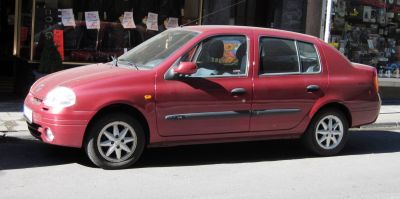 1999 Kia Rio I Sedan (DC) Dimensions, Size & Specs
1999 Kia Rio I Sedan (DC) Dimensions, Size & SpecsMeasurements of the 1999 Kia Rio I Sedan, engineered for optimal performance and comfort
| Dimensions | |
|---|---|
| Length: | 4215 mm165.9 in13.8 ft |
| Width: | 1675 mm65.9 in5.5 ft |
| Height: | 1440 mm56.7 in4.7 ft |
| Trunk Capacity: | 261-326 liter9.2-11.5 cu ft |
| Weight Specifications | |
| Curb Weight: | 940-985 kg2072-2172 lbs |
| Maximal permitted Weight: | 1409-1435 kg3106-3164 lbs |
| Tire Specifications | |
| Rims Sizes: |
|
| Tire Sizes: |
|
The Kia Rio I Sedan (DC), produced between 1999 and 2002, is a compact sedan that delivers a balanced blend of size, practicality, and lightweight design. Measuring 4215 mm (165.9 inches) in length, 1675 mm (65.9 inches) in width, and 1440 mm (56.7 inches) in height, this vehicle fits well within the compact car segment, making it suitable for urban driving and parking in tight spaces. Its curb weight ranges from 940 to 985 kg (2072 to 2171 lbs), highlighting its light and agile nature which helps in fuel efficiency and handling. The maximum gross weight lies between 1409 and 1435 kg (3106 to 3162 lbs), accommodating passengers and cargo efficiently. The luggage capacity is practical for a compact sedan, ranging from 261 to 326 liters (9.2 to 11.5 cubic feet), providing enough space for everyday needs such as groceries or small luggage. Equipped with rims sized at 13 or 14 inches and tire sizes of 175/70 R13 and 175/65 R14, the Kia Rio I Sedan offers decent grip and ride comfort for its class. This generation Rio stands out for its modest external dimensions paired with sufficient interior space, making it appealing for budget-conscious buyers seeking an economical and reliable sedan from the late 1990s to early 2000s.
Discover the standout features that make the 1999 Kia Rio I Sedan a leader in its class
Have a question? Please check our knowledgebase first.
The Kia Rio I Sedan (DC), produced from 1999 to 2002, measures 4215 mm (165.9 inches) in length, 1675 mm (65.9 inches) in width, and 1440 mm (56.7 inches) in height. These dimensions place it comfortably within the compact sedan category, offering a practical and manageable footprint ideal for urban driving and parking.
The curb weight of the Kia Rio I Sedan ranges between 940 kg and 985 kg (2072 to 2171 lbs), depending on specific configurations and trims. The maximum permissible weight varies from 1409 kg to 1435 kg (3107 to 3162 lbs), which includes passengers, cargo, and additional load. This relatively light weight contributes to the car’s fuel efficiency and nimble handling.
The luggage capacity of the Kia Rio I Sedan (DC) falls between 261 and 326 liters (9.2 to 11.5 cubic feet). This volume is adequate for typical daily use such as grocery shopping, small luggage for travel, or carrying work supplies. While it doesn’t offer the massive cargo space of larger sedans or hatchbacks, it strikes a balance between compact size and practical storage.
The Kia Rio I Sedan is compatible with rim sizes of 13 inches and 14 inches. Correspondingly, tire sizes include 175/70 R13 and 175/65 R14. These sizes contribute to a smooth ride quality and balanced handling characteristics suitable for the vehicle’s compact structure.
Yes, the Kia Rio I Sedan's compact dimensions make it well-suited for standard home garages. Most single-car garages generally measure approximately 2.4 to 3 meters (7.9 to 9.8 feet) in width and at least 5.5 meters (18 feet) in length. With a length of 4.215 meters (13.83 feet) and a width of 1.675 meters (5.49 feet), this vehicle easily fits within these standard garage spaces, allowing comfortable clearance for doors and movement around the car.
The Kia Rio I Sedan released in 1999 was essentially the first generation in many markets, as the model originally debuted around this time internationally. However, if compared to concept or earlier prototypes preceding mass production, the 1999-2002 Rio offered a more refined and slightly larger package, improving passenger room and trunk capacity. The design was aimed at maximizing compactness while optimizing interior space, giving it a competitive edge in the subcompact sedan class when it first appeared.
The Kia Rio I Sedan was slightly more compact compared to many popular compact sedans from the late 1990s and early 2000s, such as the Honda Civic and Toyota Corolla. With a length of approximately 4215 mm (165.9 inches), it was generally shorter, making it easier to maneuver in tight urban settings. Its width of 1675 mm (65.9 inches) is also modest compared to competitors, which often exceed 1700 mm (67 inches). This size positioned the Rio as a nimble and practical option for city driving, though some rivals offered more interior space and slightly larger cargo capacity.
The Kia Rio I Sedan stands 1440 mm (56.7 inches) tall, which is consistent with a low but comfortable profile typical for sedans of its class. While specific ground clearance values are not specified here, this height contributes to a low center of gravity that aids handling and stability, especially in urban traffic. The modest height also makes parking in low-clearance areas easier, such as underground garages or parking decks.
To maintain optimal vehicle dynamics and ride comfort, Kia recommends the use of 13-inch rims fitted with 175/70 R13 tires or 14-inch rims with 175/65 R14 tires for the Rio I Sedan (DC). These tire profiles and sizes provide a balanced cushion against road imperfections while ensuring effective handling response. Using the recommended sizes also assures compatibility with the vehicle's braking system and suspension setup, ultimately supporting safe driving conditions.
With a curb weight ranging from 940 to 985 kg (2072 to 2171 lbs), the Kia Rio I Sedan is considered lightweight compared to many contemporaries, which contributes positively to its fuel efficiency and performance. Subcompact sedans of the late 1990s often weighed between 950 and 1100 kg (2094 to 2425 lbs). The Rio’s relatively lower weight helps reduce fuel consumption and improve acceleration, making it an economical choice for drivers prioritizing cost-effective daily commuting. Its light build does not compromise safety but makes it more agile than heavier competitors.
Discover similar sized cars.

| Production: | 1971-1979 |
|---|---|
| Model Year: | 1971 |
| Length: | 4150 mm163.4 in |
| Width: | 1650 mm65.0 in |
| Height: | 1410 mm55.5 in |

| Production: | 1993-1999 |
|---|---|
| Model Year: | 1993 |
| Length: | 4109-4144 mm161.8-163.1 in |
| Width: | 1640-1646 mm64.6-64.8 in |
| Height: | 1408-1424 mm55.4-56.1 in |

| Production: | 1994-2000 |
|---|---|
| Model Year: | 1994 |
| Length: | 4164 mm163.9 in |
| Width: | 1640 mm64.6 in |
| Height: | 1414 mm55.7 in |

| Production: | 1999-2002 |
|---|---|
| Model Year: | 1999 |
| Length: | 4150 mm163.4 in |
| Width: | 1639 mm64.5 in |
| Height: | 1416 mm55.7 in |

| Production: | 1999-2002 |
|---|---|
| Model Year: | 1999 |
| Length: | 4163 mm163.9 in |
| Width: | 1640 mm64.6 in |
| Height: | 1424 mm56.1 in |

| Production: | 1999-2011 |
|---|---|
| Model Year: | 1999 |
| Length: | 4110-4275 mm161.8-168.3 in |
| Width: | 1710 mm67.3 in |
| Height: | 1430 mm56.3 in |
